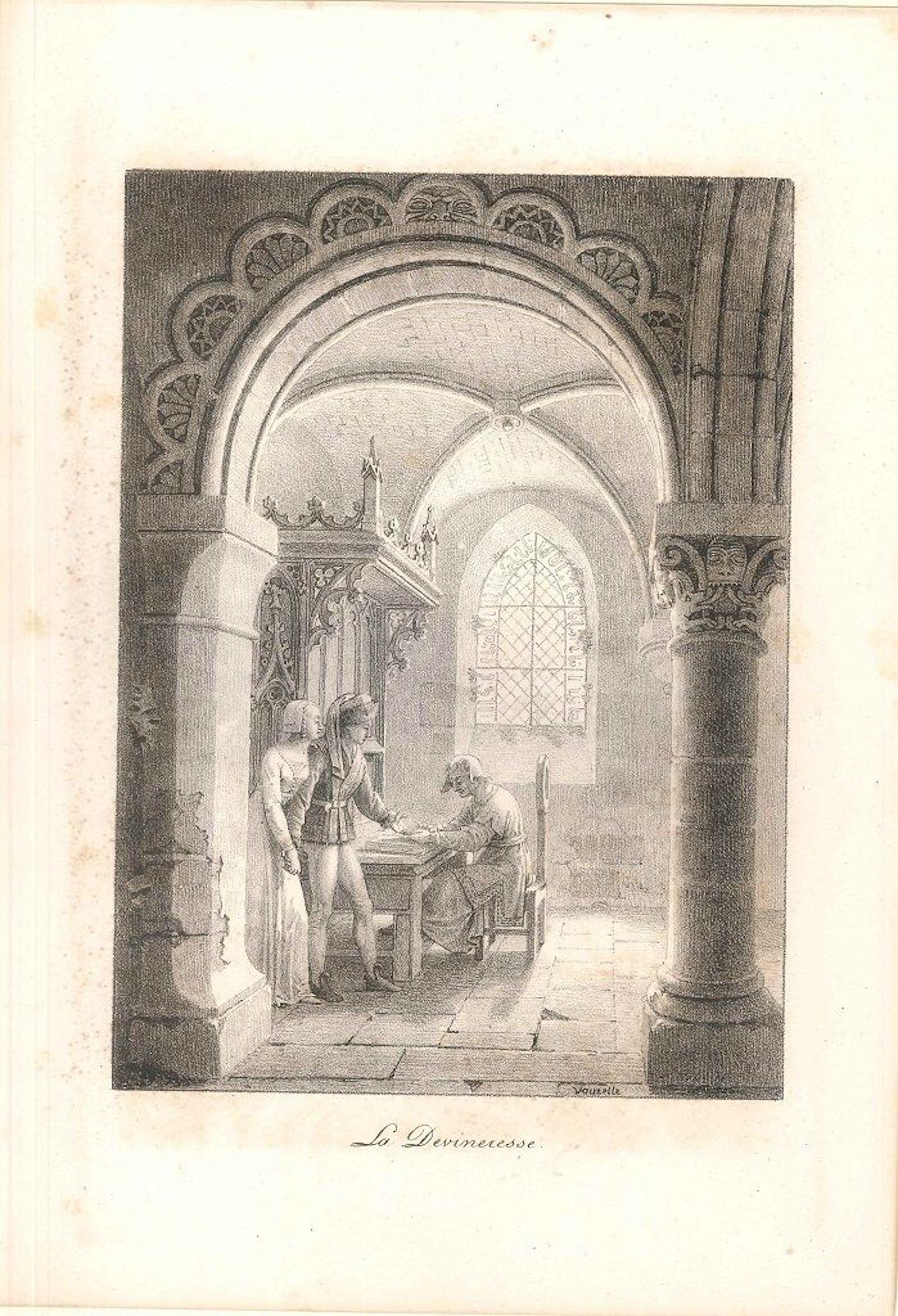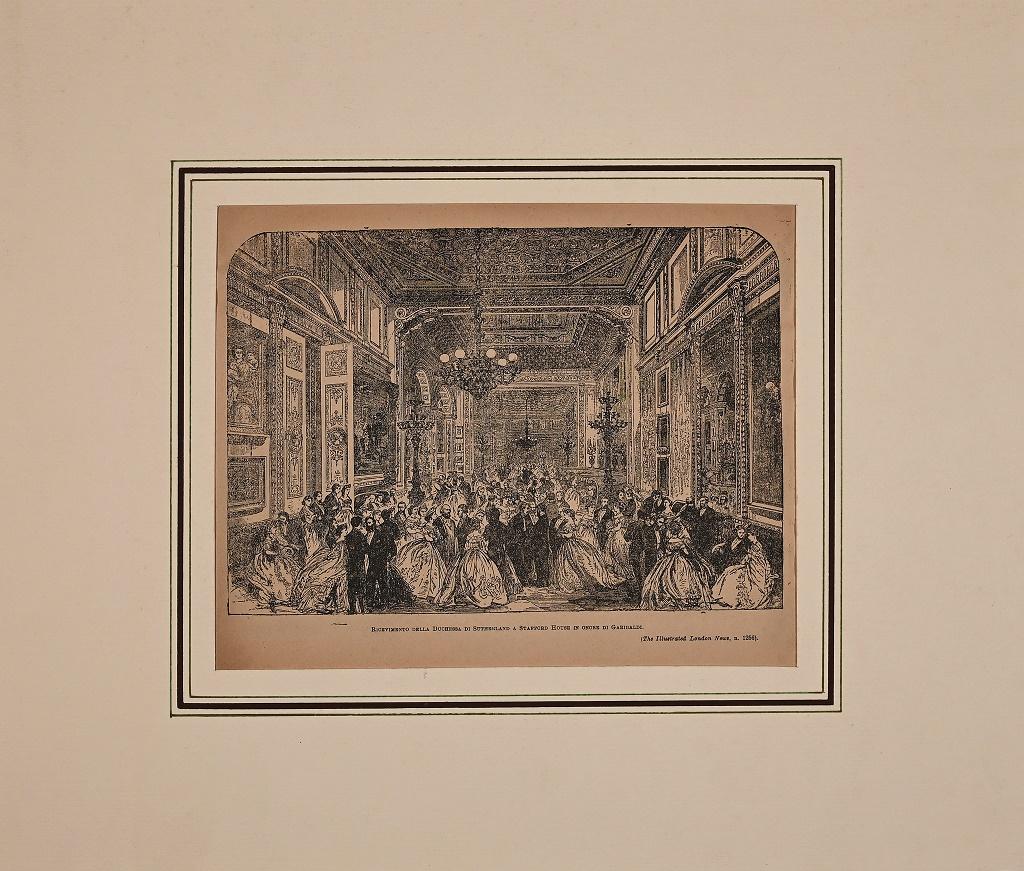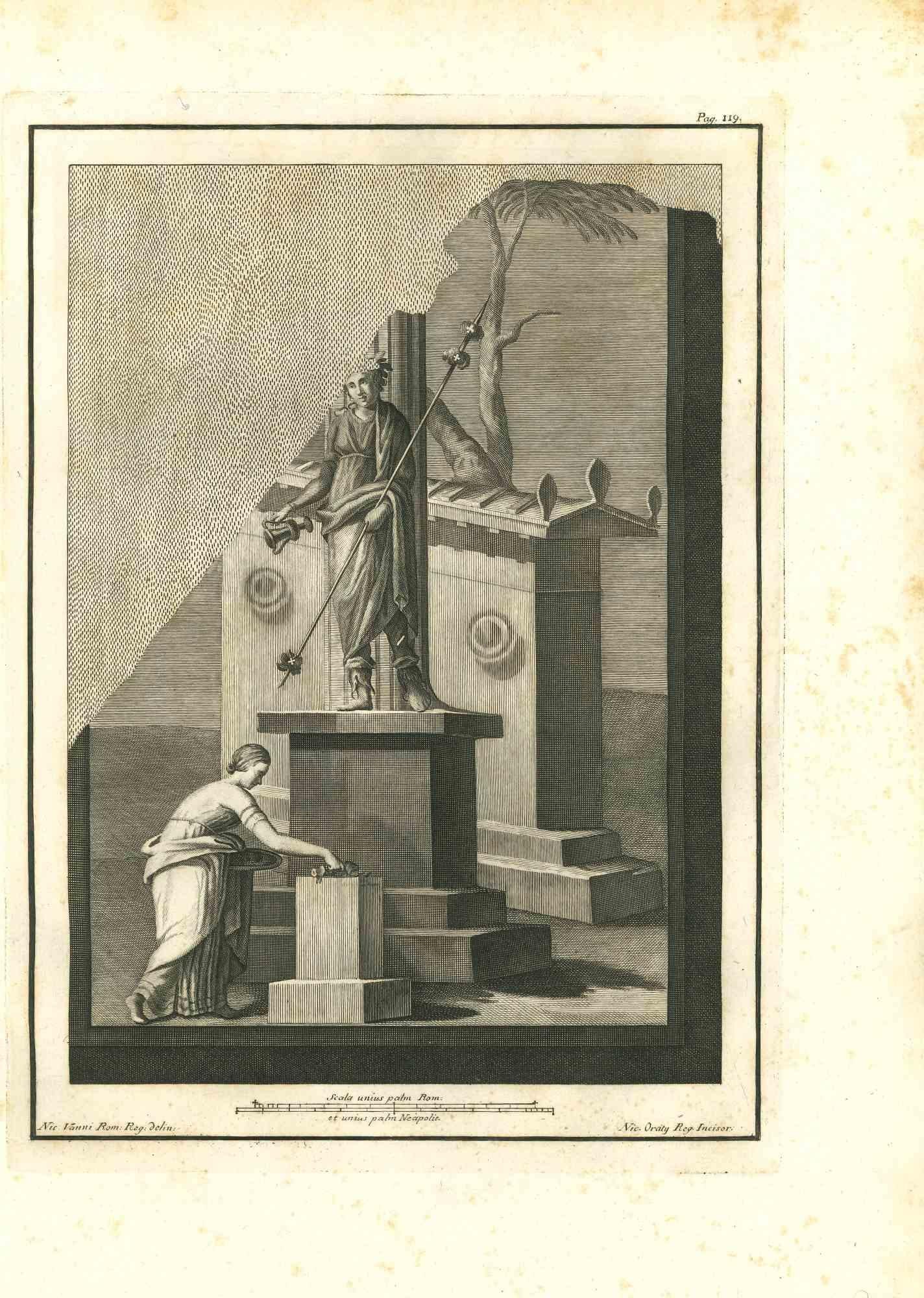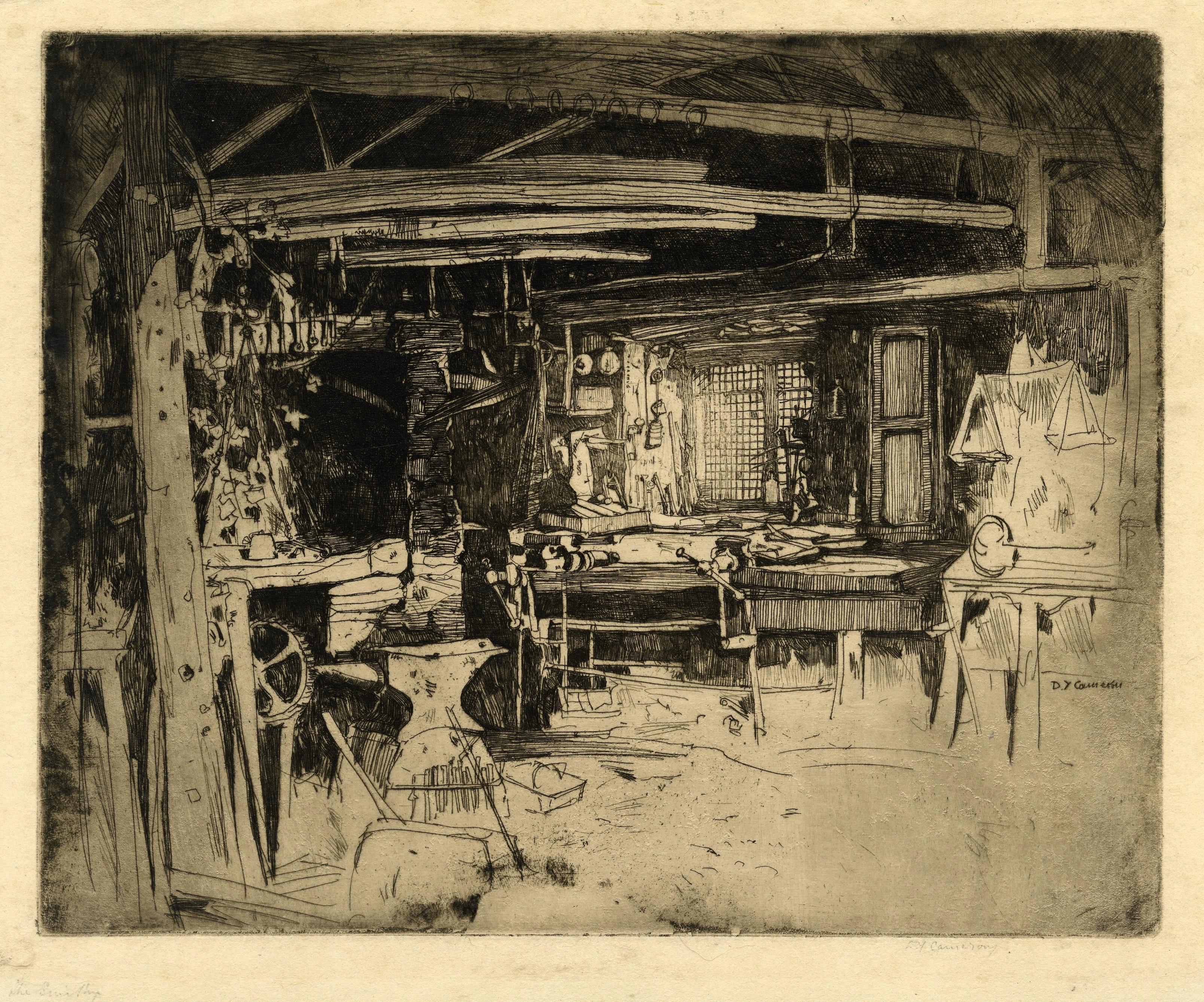Items Similar to Frontispiece from "Carceri d'Invenzione" - Etching by G. B. Piranesi - 1749/59
Want more images or videos?
Request additional images or videos from the seller
1 of 6
Giovan Battista PiranesiFrontispiece from "Carceri d'Invenzione" - Etching by G. B. Piranesi - 1749/591749/50
1749/50
About the Item
Carcere d'Invenzione is an original Modern Artwork realized by Giovan Battista Piranesi (Mogliano Veneto, 1720 - Rome, 1778).
Original Etching with Burin details on Laid paper. I state.
Inscripted in the center, in imitation of a carved epigraph: "INVENTIONS / CAPRIC OF PRISONS / ALL ACQVA FORTE / DATED IN LVCE / BY YOUNG PEOPLE / BOUCHARD IN / ROME MERCANTE / AL CORSO".
Print dimensions: mm 545 x 410; sheet dimensions: mm 635 x 494.
This beautiful specimen belongs to the first edition 1749/50.
In excellent conditions.
Reference:
Hind, Arthur Mayer, Giovanni Battista Piranesi : a critical study with a list of his published works and detailed catalogues of the prisons and the views of Rome, London, Cotswold Gallery, 1922, 1. (ed. consultata London, Holland Press, 1967), p. 24, n. 1;
Focillon Henri, Giovanni Battista Piranesi, ediz. italiana a cura di Maurizio Calvesi e Augusta Monferini, Bologna, Alfa, 1967, p. 285, n. 24;
Robison Andrew, Piranesi. Early architectural fantasies. A Catalogue Raisonné of the Etchings, Washington, National Gallery of Art, 1986, n. 29/II;
Wilton-Ely John, Giovanni Battista Piranesi. The complete etchings, San Francisco, AlanWofsy, 1994, n. 26;
Ficacci Luigi, Piranesi. The complete etchings, Koln, Taschen, 2000 (ed. 2001), pp. 128-153.
The scene is an example of the entire cycle, one of the most cryptic and technically complex due to the creative genius of the Venetian engraver. The title is placed on a huge gravestone, placed close to a wall; walkways leading in different directions and a wide staircase are described on the right while a chained figure, characterized by a dramatically tense expression, is outlined above the title and dominates the entire composition. The representation closes on the left with a part of the wall arch that seems to open the viewer's gaze on a world of anguish and fear.
Many states have been identified - nine those reported by Robison - even after the artist's death, when the branches were purchased by the publisher Firmin-Didot, which in 1835-1839 succeeded with a fifth edition. Focillon carefully details the question of the dating of the first edition and the different theses expressed by scholars starting as early as the end of the 18th century; many agree in distinguishing the engraving of the plates, to be traced back to about 1745, from their publication, which took place around 1750, while the final enlarged edition of two tables would be placed between 1760 and 1761. Several drawings can be traced back to the plates of the series. .
Giovanni Battista Piranesi, also known as Giambattista (Venice, 1720 - Rome, 1778), was an Italian engraver, architect and theorist of architecture. His engraved tables, marked by dramatic intonation and graphics, appear to be marked by an idea of Roman dignity and magnificence, expressed through the grandeur and isolation of the architectural elements, in order to arrive at a sublime feeling of grandeur of the ancient past, although marked by inexorable abandonment. The eclecticism of his works and the versatility of his creative inspiration make Piranesi an artist difficult to insert within a schematic dictated by a subdivision into styles or artistic currents. A personality with a double cultural matrix, Venetian and Roman, Piranesi has a very complex artistic physiognomy, which can be divided into three fundamental components. In fact, Piranesi's art has deep roots in the Rococo tradition, of which he is one of the last heirs. This adherence to Rococo can be found not only in the quality of the design, unmade and evocative, but above all in the very nature of his works, which are configured as capricious inventions (as we read in the title page of the Carceri): with this exquisitely Rococo name, in fact , Piranesi wanted to indicate the imaginative and unusual character of his creations.
- Creator:Giovan Battista Piranesi (1720 - 1778)
- Creation Year:1749/50
- Dimensions:Height: 25.2 in (64 cm)Width: 19.69 in (50 cm)Depth: 0.04 in (1 mm)
- Medium:
- Movement & Style:
- Period:
- Framing:Framing Options Available
- Condition:Insurance may be requested by customers as additional service, contact us for more information.
- Gallery Location:Roma, IT
- Reference Number:
About the Seller
4.9
Platinum Seller
These expertly vetted sellers are 1stDibs' most experienced sellers and are rated highest by our customers.
1stDibs seller since 2017
6,813 sales on 1stDibs
Typical response time: 3 hours
- ShippingRetrieving quote...Ships From: Rome, Italy
- Return PolicyA return for this item may be initiated within 14 days of delivery.
More From This SellerView All
- Le Peseur d'Or - Original Etching by Léopold Flameng - 1873By Léopold FlamengLocated in Roma, ITLe Peseur d'Or (The Money Exchanger) is a wonderful black and white etching on wire rod cream-colored paper, realized by Léopold Flameng, an after by the Flemish artist Gabriel Metsu...Category
1870s Modern Figurative Prints
MaterialsEtching
- La Devineresse - Original Etching by J-L Vauzelle - End of 18th CenturyLocated in Roma, ITLa Devineresse is an original artwork realized by Jean-Lubin Vauzelle in the second half of the XVIII century. Original etching on paper. Passepartout included (39 x 28.5 cm). Sign...Category
Late 18th Century Modern Figurative Prints
MaterialsEtching
- Chez François Bouvin - Original Etching After François Bouvin by Charles CoutryBy Charles CoutryLocated in Roma, ITChez François Bouvin is a wonderful etching realized in 1891 by Charles Courtry, after François Bouvin. This Modern artwork representing a scene of ordinary life, is a beutiful arti...Category
1890s Modern Interior Prints
MaterialsEtching
- Reception of the Duchess of Sutherland - Original Zincography - 1864Located in Roma, ITReception of the Duchess of Sutherland is an original zincography realized by an artist of the 19th century (1864). The artwork represent the re...Category
1860s Modern Interior Prints
MaterialsEtching, Paper
- Ancient Roman Painting - Etching by N. Orcity, N. Vanni - 18th CenturyLocated in Roma, ITAncient Roman painting- Offering Scene from the series "Antiquities of Herculaneum", is an original etching on paper realized by Nic Orcity an...Category
18th Century Modern Figurative Prints
MaterialsEtching
- Chez Le Patissier - Original Etching by J.E. Laboureur - 1924By Jean-Emile LaboureurLocated in Roma, ITHand signed. Signed and titled on plate. Very good conditions. This artwork is shipped from Italy. Under existing legislation, any artwork in Italy created over 50 years ago by an a...Category
1920s Modern Figurative Prints
MaterialsEtching
You May Also Like
- The SmithyBy Sir David Young Cameron, R.A.Located in Middletown, NYA warm composition, in theme and tone; the creaky timber interior of a 19th century Scottish blacksmith's shop. Etching and drypoint on cream laid Japan paper, 8 x 10 inches (202 x ...Category
Late 20th Century Modern Interior Prints
MaterialsDrypoint, Laid Paper, Etching
- Interiors I: Family Reunion — A penetrating scene with a hidden homage to EadweaBy Peter MiltonLocated in Middletown, NYInteriors I: Family Reunion 1984 Resist ground etching and engraving on BFK Rives wove paper, 20 x 36 inches (501 x 913 mm), full margins. Signed, titled, dated and numbered 49/175 in pencil, lower margin. In excellent condition with minor mat tone. A luminous, rich, and well-inked impression of this haunting image, with astonishing detail and depth. Framed handsomely under museum grade glass with archival materials in a solid wood frame with silver finish. [Milton 107] Intended to be a stand alone image in its inception, Family Reunion ended up spawning seven additional images, and became a sort of Primo Pensiero in the sprawling, masterpiece suite now known as Interiors. The suite took eight years to complete, and consists of works of varying format, psychological intensity, and subject matter. The thematic darkness in the eight images waxes and wanes, and Milton intentionally included several interlude works to lighten the tension he felt while composing several of the darker images. The first two in the series, Family Reunion, and Hotel Paradise Café, were meant to be companion pieces. The equilibrium of each composition is anchored on a central brooding figure; a man (perhaps based on a Thomas Eakins portrait of the American anthropologist Frank Hamilton...Category
1980s American Modern Figurative Prints
MaterialsEtching, Engraving
- Interiors VII: The Train from MunichBy Peter MiltonLocated in Middletown, NYInteriors VII: The Train from Munich Robert E. Townsend, 1991. Resist ground etching and engraving with hand refinement in charcoal, pencil, stabilo, and eraser on BFK Rives white wove paper, 20 x 36 inches (507 x 914 mm), full margins. Signed, titled, dated and numbered 51/175 by the artist in pencil, lower margin. A brilliant, inky impression with luminous light and gradient tones. In excellent condition with one extremely minor and superficial spot of light tan adhesive residue on the verso, unobtrusive and not visible on the recto, with no other visible defects. With the blind stamp of the printer, Robert E. Townsend in the lower left margin. An especially fine impression in superb condition. [Milton 113]. When asked about this work in particular, Milton expressed that his favorite images were his darkest images, in theme, mood, and in ink. Milton, who has said that his work is infused with a postmodern awareness of the past, has focused here in a deeply personal way on a segment of history that continues to haunt us all. The work, published in 1991, evokes one of the darkest periods of European history, the eroding and erasing of European culture under fascism, and the eventual total loss of humanity. The Train from Munich is an especially relevant and emotional work for Milton, who created the piece for his wife, Edith, who escaped Munich in 1939 as a child on the fabled Kinderstransport. The Kinderstransport was a desperate rescue effort on the part of the British government to save as many Jewish children as possible by railway before borders closed on the precipice of the Second World War. Children left their parents behind, and boarded the trains alone, leaving the impending doom of Nazi Germany, they arrived in Great Britain as refugees. More than 10,000 children escaped the holocaust via the Kinderstransport. In Train from Munich, the image itself holds an almost immeasurable amount of symbolism; each inch of the matrix is a successful effort to confront this history in a way that is poignant through a series of motifs. We see the Café disappearing into a ghostlike memory of the past, an allegory to the disintegration of culture, while through the windows we can see a rampant, snarling dog; a portrait of Hitler's shepherd, Blondi. Blondi isn't the only notable figure in the composition. Milton has pointed out that the fading figure of the doorman at the Hotel Metropole is modeled after the artist and intellectual Marcel Duchamp, and the face of the young girl peering...Category
1990s American Modern Interior Prints
MaterialsABS, Charcoal, Engraving, Etching
- (Four Women at Hat Store)Located in New York, NYThis is such an interesting image. Are there 'Four women'? Is the head on the upper right from a hat store or is she another person in the scene. And what a...Category
Mid-20th Century American Modern Figurative Prints
MaterialsEtching
- KnackersBy William Strang, R.A., R.E.Located in New Orleans, LABinyon 232 - A fine impression in fine condition in an edition of 55 signed and inscribed by the artist. Strang was a prolific printmaker and across his lifetime produced over 750 o...Category
1890s Modern Figurative Prints
MaterialsEtching
- Bernard Sanders, Man at PianoLocated in New York, NYFor a print that's nearly one hundred years old it feels very contemporary. Signed and titled in pencil. Besides the etching I think there is some false biting that adds tone here.Category
Early 20th Century American Modern Interior Prints
MaterialsEtching
Recently Viewed
View AllMore Ways To Browse
18th Century Nature Engraving
Rococo Venice
18th Century Italian Rococo Table
Antique Architectural Staircases
Wilton Antique
Alfa Italy
Ancient Views Of San Francisco
Augustas John
N 153
Giovan Battista Piranesi
Firmin Didot
Italian 18th Century Specimen Table
Childrens Vintage Clothing
Ehret Botanical Prints
Framed Vintage World Map
G Roy Signed
German Stein Vintage
Kaws Street Poster





